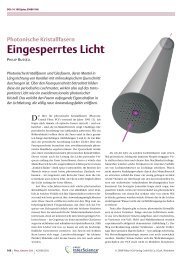Diploma thesis
Diploma thesis
Diploma thesis
Create successful ePaper yourself
Turn your PDF publications into a flip-book with our unique Google optimized e-Paper software.
kSHG(762.5nm) 14.2703/ µm<br />
kp1(1525nm) 7.01723 / µm<br />
kp2(1525nm) 7.34502/ µm<br />
kΛ=104.17µm 0.0603166 / µm<br />
-0.0313867 / µm<br />
kerr<br />
Table 4.4: Calculated k-vectors of the observed degenerate SHG process<br />
Figure 4.40: Corrected phasematching Figure 4.41: Corrected phasematching 2d<br />
The fit now relies on three data points, instead of one in the two previous section.<br />
This is a great increase in reliability. Still with this one error parameter it is not<br />
possible to move all three degeneracy points in the right places. In addition the kE<br />
parameter is not invariant under the change of waveguides or grating periods. A<br />
fully numerically approach to calculate the effective sellmeier equations may solve<br />
the last discrepancies.<br />
Nevertheless we gained important data. Despite minor quantitative variations<br />
the prognoses are valuable, and as demonstrated in this chapter, have already been<br />
tested successfully.<br />
4.4 PDC experiments<br />
Having evaluated the SHG experiments we decided to use crystal ITI0706-B12 with<br />
a poling period of 104.17 µm. According to our data we should be able to generate<br />
degenerate PDC photon pairs in the range between 1520 to 1560 nm.<br />
The goal was to verify the existence of parametric downconversion in the predicted<br />
frequency regime. To detect the photons we applied the id201 single photon counting<br />
modules, tested in Section 4.1. Great care has to be taken not to confuse PDC with<br />
59



